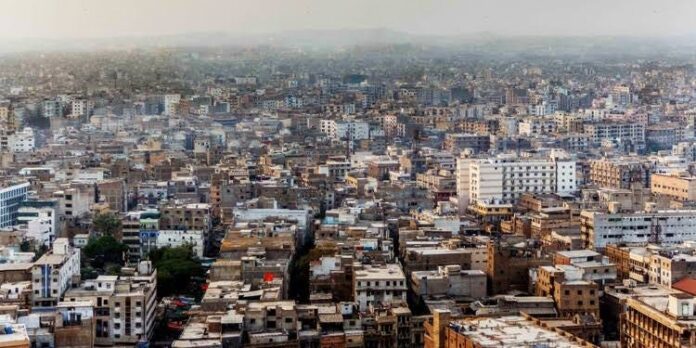“A city is not gauged by its length and width, but by the broadness of its vision and the height of its dreams,” wrote Herb Caen. If this holds true, Karachi—a city that once symbolized boundless ambition—now struggles under the weight of its own unrealized potential. Once celebrated as the heart of Pakistan’s economic and cultural progress, it now teeters on the edge of dysfunction, pleading for redemption from decades of neglect and mismanagement.
Karachi, a city once brimming with ambition and promise, now languishes in the shadows of its former glory. The metropolis that once stood as Pakistan’s economic powerhouse is now a forsaken urban sprawl, marred by neglect, misgovernance, and a staggering decline in livability. Once a beacon of opportunity, Karachi has been reduced to a relentless test of endurance for its residents. Known for its booming industry, bustling streets, and diverse communities, it has become a city where survival is a daily struggle. Despite contributing nearly 60% of the country’s revenue, it suffers from crumbling infrastructure, rampant crime, and an administration that appears indifferent or complicit in its decline. According to a recent World Bank report, Karachi ranks among the least livable cities in the world due to its poor infrastructure and governance failures. The city’s decay is not merely a tragedy for its residents but a national crisis that threatens Pakistan’s economic stability and global standing. Karachi’s downfall is not just a result of mismanagement but of deliberate neglect, leaving millions of residents to fend for themselves amid mounting chaos. The forsaken metropolis now teeters on the brink, struggling for redemption in the face of political indifference and systemic dysfunction. If urgent, collective action is not taken, Pakistan risks losing its most vital economic hub to a downward spiral that may become irreversible.
This decline did not happen overnight; it has been decades in the making. Karachi’s transformation from a thriving, cosmopolitan center to a city in distress is the outcome of years of corruption, political infighting, and poor urban planning. The city, once renowned for its open spaces, efficient transport, and safe neighborhoods, has been overrun by unchecked expansion and infrastructural decay. The failure to implement long-term urban development strategies has led to congested roads, insufficient public services, and an overwhelmed healthcare system. The absence of a coherent vision has left Karachi in the hands of opportunistic politicians and bureaucrats who prioritize short-term electoral gains over sustainable development. Meanwhile, the influx of displaced populations due to conflicts and climate-induced migration has further strained Karachi’s fragile resources. Without a well-structured and inclusive urban revival plan, Karachi’s redemption will remain an elusive dream.
The contradictions within Karachi are striking. Home to an estimated 20 million people, it contributes roughly 25% to the nation’s GDP and handles the vast majority of its foreign trade. Yet, this dynamic metropolis grapples with deep-seated issues of inequality, infrastructure decay, and governance failures, which hinder its progress and diminish the quality of life for its residents. Opulent gated communities exist alongside sprawling slums; towering skyscrapers overlook streets riddled with potholes; and a thriving business sector operates amidst crumbling public services. A 2023 UNDP report revealed that 60% of Karachi’s residents live in informal settlements, lacking proper housing and sanitation facilities. Meanwhile, the Karachi Water and Sewerage Corporation (KWSC) struggles to meet the city’s water demands, exacerbated by a corrupt tanker mafia that thrives on government inefficiencies. The Asian Development Bank estimates that over 40% of the city’s water supply is lost due to leakage and theft. Public transportation remains abysmal, with the Karachi Circular Railway a ghost project and the Bus Rapid Transit (BRT) system plagued by mismanagement and delays. Alarmingly, a recent surge in traffic accidents has claimed 39 lives in just the first 37 days of 2025, underscoring the lack of urban planning and regulatory enforcement. Without immediate investments and structural reforms, Karachi will continue its descent into urban chaos, with dire consequences for its millions of residents.
Adding to the crisis, Karachi has become an increasingly dangerous place to live due to the breakdown of law and order. Crime syndicates, land mafias, and extortion networks operate with impunity, shielded by political connections. According to the Citizens-Police Liaison Committee (CPLC), over 40,000 mobile phones were snatched in Karachi in 2023 alone, with the police often complicit in criminal activities rather than serving as protectors of the people. The much-touted “Safe City” project, aimed at improving surveillance and security, has been slow to materialize, leaving residents vulnerable to crime. Furthermore, street crimes, kidnappings, and targeted killings have made citizens feel abandoned by the state, further diminishing confidence in law enforcement agencies. A grim reminder of the lawlessness is the staggering toll of 36 dead and 528 injured in Karachi due to violence and mismanagement in 2025 alone. If crime continues unchecked, Karachi will become a breeding ground for organized crime and lawlessness, pushing businesses and investors away and further deepening the city’s crisis.
Politically, Karachi has been treated as little more than a pawn in power struggles. Successive governments have used the city for electoral gains while abandoning it when it comes to governance. The Sindh government, in power for over a decade, has shown little interest in resolving the city’s core issues, while the federal government conveniently distances itself from responsibility. The 18th Amendment to the Constitution devolved power to provincial governments, but critics argue this has led to mismanagement and a lack of accountability. The absence of a strong and effective local government has exacerbated the crisis, with decisions made without considering the needs of Karachi’s residents. A recent survey by Gallup Pakistan found that 78% of Karachi’s residents believe that political infighting has directly hindered progress in the city. The latest fiasco surrounding the VVIP security arrangements for the Champions Trophy 2025 highlights the misplaced priorities of authorities, as citizens suffer from unchecked lawlessness and failing infrastructure. While provincial mismanagement has been a key factor in the city’s decline, federal authorities must also recognize their role in addressing Karachi’s issues. Without a unified commitment from both levels of government, Karachi’s decline will persist, further marginalizing its people and its economic potential.
Reviving Karachi demands more than mere rhetoric; it requires urgent, decisive action. Strengthening local government and promoting greater accountability are crucial steps toward ensuring better governance. Sustainable urban development must replace cosmetic projects, ensuring that infrastructure serves the people rather than being a tool for political gain. The city must receive significant investment in transportation, water supply, sanitation services, and renewable energy sources. Law enforcement agencies must be depoliticized and modernized to restore security and trust among citizens. Reforming the police and judicial systems is vital to address crime and improve public safety. Moreover, education and healthcare must be prioritized, ensuring access for all residents through increased funding and systemic improvements. Additionally, lessons must be drawn from other global cities that have successfully revitalized themselves. Cities like Bogotá and New York, once plagued by crime and urban decay, rebounded through strong governance and citizen engagement. Karachi must follow suit, embracing long-term strategies rather than short-sighted political maneuvering.
The road to redemption is daunting but not impossible. Karachi has all the potential to reclaim its past glory, but this can only happen if a collective and sustained effort is made to address its systemic failures. If Karachi continues on this downward trajectory, it will not only undermine the city’s future but also drag the entire nation into deeper socio-economic turmoil. However, Karachi’s revival is not solely the government’s responsibility; its people must recognize their collective power and demand their rights. Civil society must step up to hold those in power accountable, and the private sector should contribute to sustainable urban development. Businesses must advocate for improved infrastructure, security, and governance, ensuring their economic survival is not jeopardized by administrative failures. Karachi’s youth, professionals, and activists must push for reforms, raising awareness through civic engagement and legal means. If the government continues to fail, the people of Karachi must rise—through legal, civic, and social activism—to reclaim their city. Redemption is Karachi’s only path, and it must be pursued with unwavering determination, for the cost of failure is simply too great to bear.























